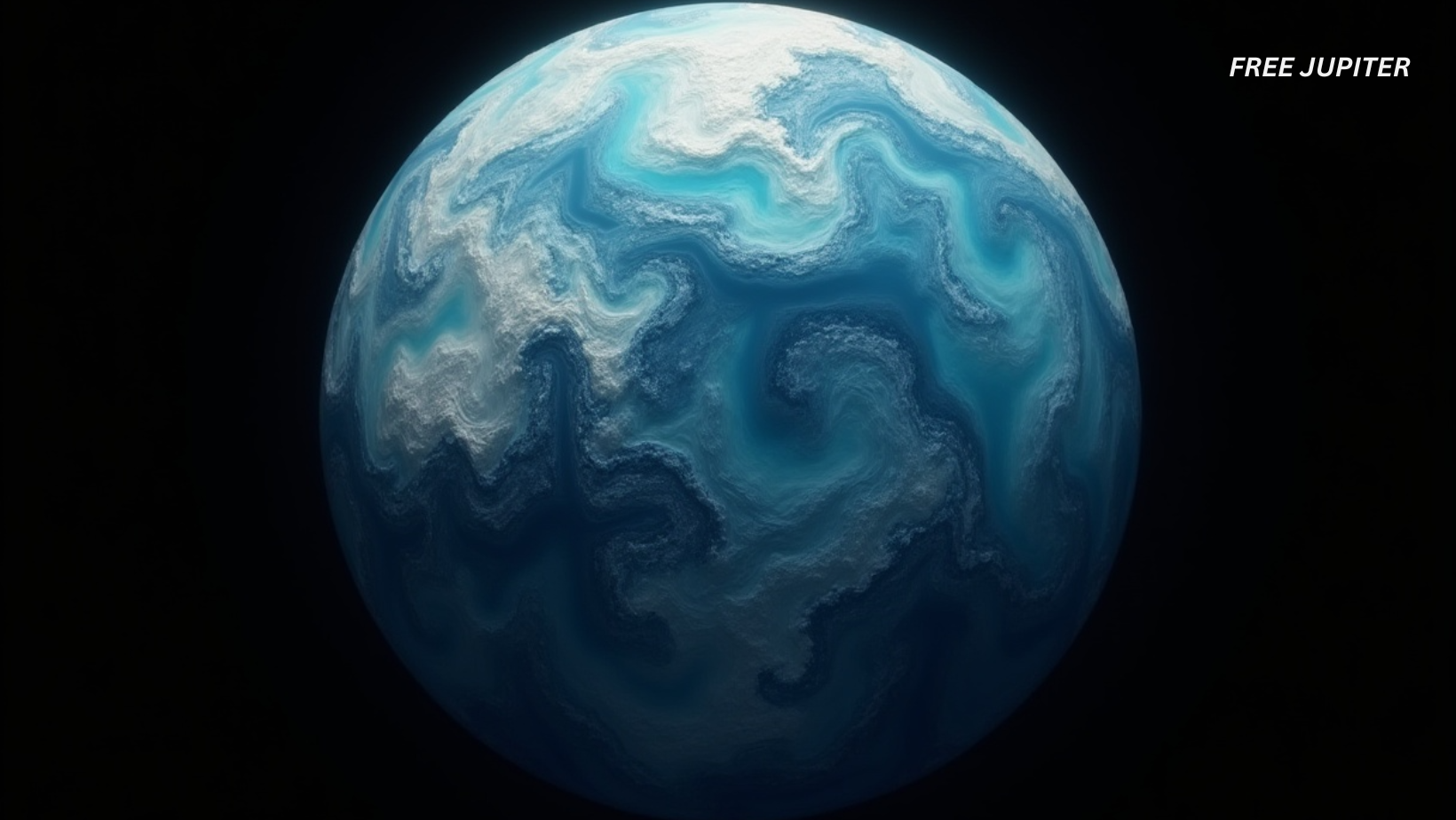Friendly Note: FreeJupiter.com shares general info for curious minds 🌟 Please fact-check all claims—and always check health matters with a professional 💙
Try to picture Earth as a completely blue marble—not just mostly ocean like today, but entirely engulfed in water. No continents. No shorelines. Not even a single patch of dry land. Just deep, endless seas stretching around the globe. According to a new scientific study, this may not just be fantasy—it could actually describe what Earth looked like between 3 and 4 billion years ago.
That means there may have been a time in Earth’s deep past when even the tallest mountains of today—Mount Everest included—would’ve been completely buried beneath waves. No sand, no trees, no deserts, and certainly no humans. Just water. Lots of it.
So what evidence do scientists have for this incredible claim? And what would life—even the start of life—have looked like on a planet so overwhelmingly wet? Let’s dive in.
A Mantle Too Hot to Handle Water
To understand how the Earth could have ended up as one giant ocean, we have to look below the surface—way below. Beneath the crust of the planet lies the mantle, a layer of hot, semi-solid rock that makes up the bulk of Earth’s interior.
Today, Earth’s mantle holds a surprising amount of water—not as liquid, but locked away inside the crystal structure of minerals. It’s estimated that the mantle might contain as much water as all the surface oceans combined. But here’s the twist: billions of years ago, the mantle was too hot to trap and hold onto water in that same way.
When the planet was still young and freshly formed, it was much hotter inside—more chaotic, more molten, more… volcanic. In those conditions, minerals couldn’t store water molecules the way they do now. So instead of soaking into the planet’s interior, that early water was expelled to the surface, accumulating in massive quantities.
The result? Oceans that may have been twice as deep as those we see today.
Read more: Instead of Cutting Down Trees, Japan Moves Them to Make Room for Roads
Goodbye Continents—At Least for a While
If you’re wondering why this means no dry land, here’s the logic. Today’s continents sit high above sea level mostly because of the buoyant, thick slabs of crust beneath them. But during Earth’s early years, those continental masses hadn’t fully formed yet. Without those continental “rafts” to rise above the water, the entire surface would have been relatively flat and low-lying.
Add in oceans twice as deep as today’s, and boom—no land in sight.
Scientists estimate that the sea level during this time may have been several kilometers higher than today. That’s enough to submerge every mountain and hill we now know. It’s hard to overstate how alien that version of Earth would look to us.
How This Much Water Might Have Kickstarted Plate Tectonics
Here’s something wild: All that water sloshing around might have helped Earth begin moving in a very specific way.
We often think of plate tectonics—the slow, grinding movement of massive slabs of Earth’s crust—as a modern phenomenon. But it’s been happening for billions of years. In fact, it’s one of the major reasons we have mountains, volcanoes, earthquakes, and even continents.
So where does water come in?
Water acts like a lubricant for rocks. It can seep into cracks, make the crust more brittle, and help sections of the Earth’s surface slide over and under each other more easily. In the early ocean-covered Earth, the presence of so much water may have weakened the rigid outer shell of the planet just enough to allow it to fracture and start moving.
This theory suggests that without all that water, Earth might have remained geologically stagnant for far longer.
What About Life—Where Could It Have Begun?
Ah yes, the ultimate question: where and how did life begin? When you imagine Earth as a completely submerged planet, the usual origin theories start to hit some snags.
For example, one of the most famous ideas is that life began in shallow ponds or tide pools—little puddles where water evaporated, concentrated nutrients, and gave molecules time to form more complex structures. But if there was no dry land, there were no tide pools.
Another popular idea? That life got started in deep-sea hydrothermal vents. These are places on the ocean floor where hot water and minerals gush from cracks in the crust. These vents still exist today, and they support entire ecosystems without any sunlight. But there’s a catch. In an Earth with oceans twice as deep, those vents may have been buried under intense pressure, possibly changing their chemistry or making them less hospitable.
So where else could life have gotten its start?
Some scientists now suggest that underwater volcanoes, also called seamounts, could have created localized environments suitable for life. These volcanic peaks may have broken through parts of the ocean and created warm, mineral-rich nooks in the otherwise uniform watery world.
Others propose that pockets within oceanic crust—tiny cavities inside rocks on the seafloor—could have offered protected spaces for early life to form. These microscopic hideaways might have kept fragile molecules safe from the vast, swirling sea.
Read more: Hero Cat Helps Scientists Uncover New Virus for the Second Time
The Crystal Clues: Ancient Zircons and Oxygen Fingerprints
This theory of a water-world Earth isn’t just based on guesswork. Scientists are digging through the oldest rocks on Earth to find real evidence.
One of the best tools for peeking into Earth’s ancient past is a tiny crystal called zircon. These crystals are incredibly durable and can survive billions of years. Inside them are chemical traces—like time capsules—that tell us about the conditions when they formed.
Some of the oldest zircons, dating back over 4 billion years, contain oxygen isotope ratios that suggest the presence of liquid water on Earth’s surface at the time they were formed. In other words, even back then, the planet may have already been dripping wet.
Meanwhile, the chemistry of ancient oceanic crust also supports the idea. Scientists look at oxygen isotopes within rocks to figure out how much interaction there was with water. The findings consistently show signs of a very wet environment early in Earth’s history.
Why This Matters—Beyond Just Curiosity
At first glance, the idea of a water-covered Earth might sound like just an interesting bit of trivia, but it actually has big implications.
For starters, it challenges long-held beliefs about how continents formed, how early life developed, and how Earth’s inner workings began. It also shapes how we think about other planets and moons. If Earth went through a phase like this, maybe other rocky planets—like Venus or Mars—had similar aquatic beginnings.
Even more intriguingly, several icy moons in our solar system, like Europa (orbiting Jupiter) and Enceladus (orbiting Saturn), are believed to have oceans beneath their frozen crusts. If life could start in Earth’s early water-world, maybe it could arise in those faraway oceans too.
So, Was Earth Always a “Blue Planet”?
We often call Earth the “Blue Planet” because about 70% of its surface is covered in water. But if this new research holds up, there was a time when that number was closer to 100%.
Imagine no deserts. No mountains. No forests. Just endless, shifting waves under a grayish-blue sky. Volcanoes may have occasionally pierced the surface, but for the most part, the world was an enormous, swirling sea—primordial, unpredictable, and brimming with potential.
It’s a humbling reminder that the Earth we know today hasn’t always looked this way. And it probably won’t look this way forever, either.
Final Thoughts: The World Before the World We Know
This new research doesn’t just suggest Earth had a wet start—it reveals how water may have been the great architect of the planet’s evolution. From shaping the surface to possibly sparking the earliest forms of life, Earth’s vast oceans weren’t just a backdrop—they were the stage on which everything began.
So next time you stand at the edge of the sea and look out at the horizon, remember: there was a time when all of Earth looked like that. And from that ocean, everything else eventually rose.










